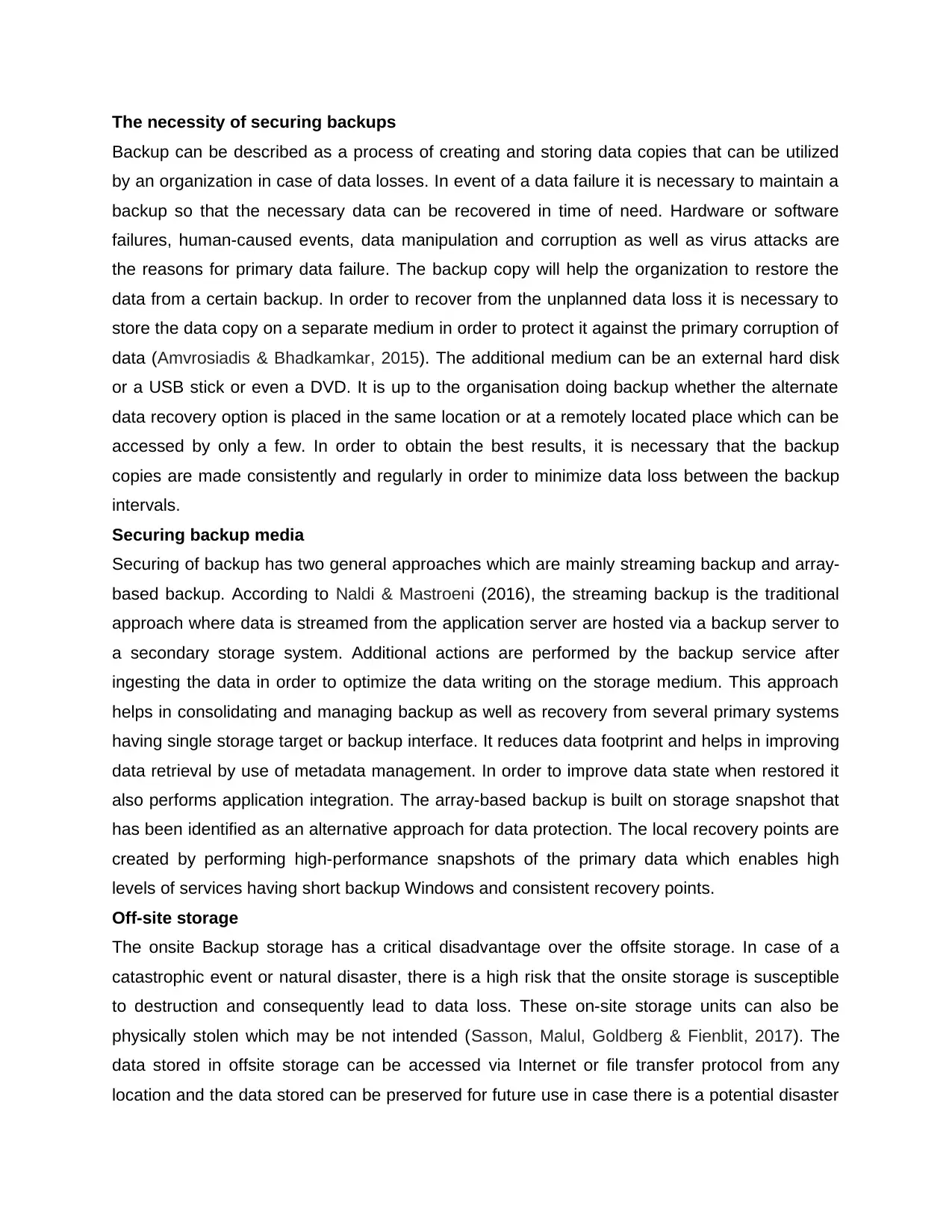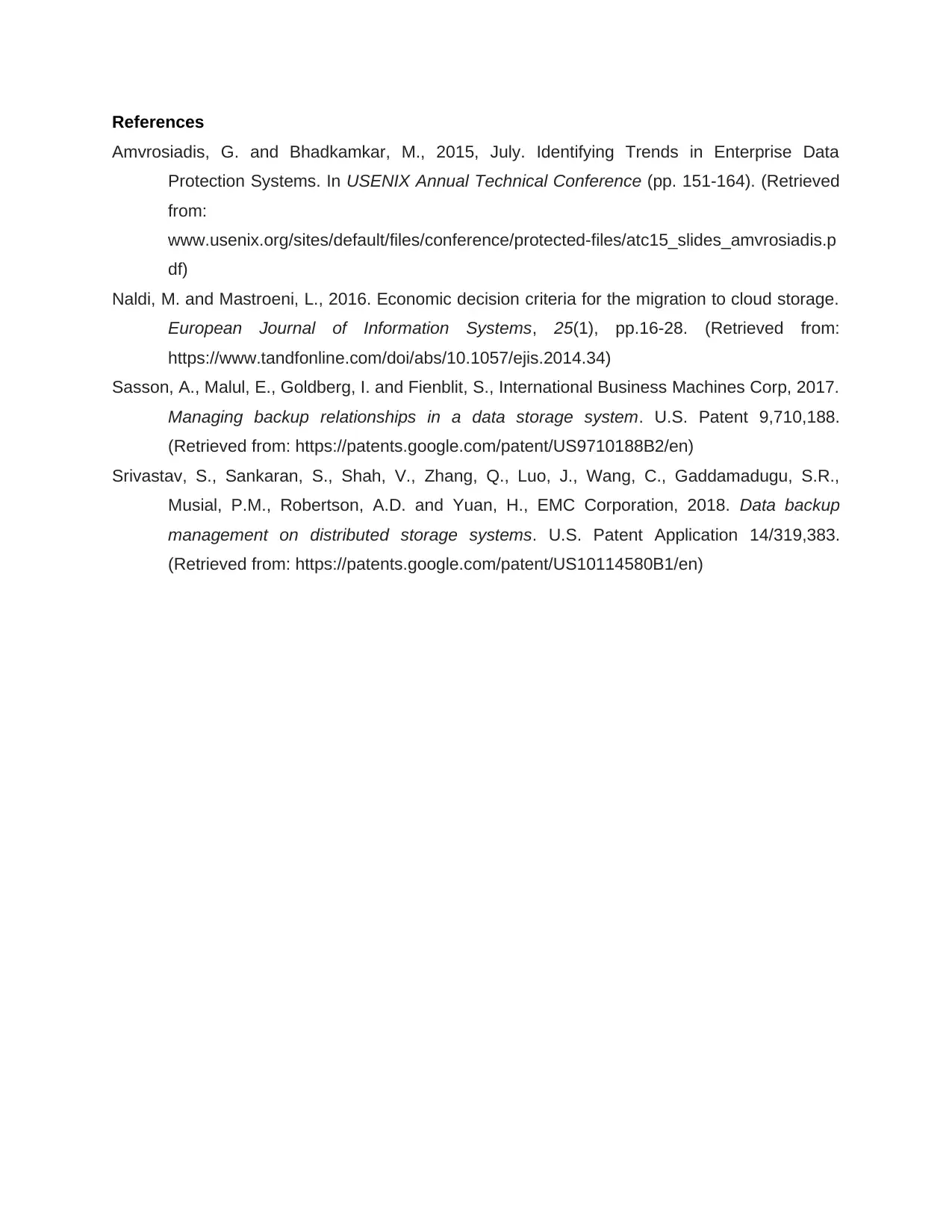Comprehensive Analysis: Securing Data Backups and Storage Solutions
VerifiedAdded on 2023/04/25
|5
|807
|305
Report
AI Summary
This report emphasizes the critical need for securing data backups to ensure business continuity and data recovery in the event of data loss due to hardware/software failures, human error, or cyberattacks. It explores two primary backup approaches: streaming backup and array-based backup, highlighting the benefits of each. The report also contrasts onsite and offsite storage solutions, noting the risks associated with onsite storage in catastrophic events and the accessibility challenges of offsite storage. It concludes that an integrated onsite/offsite solution offers the most secure and reliable data protection strategy. The document includes references to support its analysis of data protection systems, economic decision criteria for cloud storage, and data backup management on distributed storage systems. Desklib provides past papers and solved assignments for students.

MANAGEMENT
Paraphrase This Document
Need a fresh take? Get an instant paraphrase of this document with our AI Paraphraser

Table of contents
Necessity of securing backups....................................................................................................3
Securing backup media...............................................................................................................3
Off-site storage............................................................................................................................ 3
References.................................................................................................................................. 5
Necessity of securing backups....................................................................................................3
Securing backup media...............................................................................................................3
Off-site storage............................................................................................................................ 3
References.................................................................................................................................. 5

The necessity of securing backups
Backup can be described as a process of creating and storing data copies that can be utilized
by an organization in case of data losses. In event of a data failure it is necessary to maintain a
backup so that the necessary data can be recovered in time of need. Hardware or software
failures, human-caused events, data manipulation and corruption as well as virus attacks are
the reasons for primary data failure. The backup copy will help the organization to restore the
data from a certain backup. In order to recover from the unplanned data loss it is necessary to
store the data copy on a separate medium in order to protect it against the primary corruption of
data (Amvrosiadis & Bhadkamkar, 2015). The additional medium can be an external hard disk
or a USB stick or even a DVD. It is up to the organisation doing backup whether the alternate
data recovery option is placed in the same location or at a remotely located place which can be
accessed by only a few. In order to obtain the best results, it is necessary that the backup
copies are made consistently and regularly in order to minimize data loss between the backup
intervals.
Securing backup media
Securing of backup has two general approaches which are mainly streaming backup and array-
based backup. According to Naldi & Mastroeni (2016), the streaming backup is the traditional
approach where data is streamed from the application server are hosted via a backup server to
a secondary storage system. Additional actions are performed by the backup service after
ingesting the data in order to optimize the data writing on the storage medium. This approach
helps in consolidating and managing backup as well as recovery from several primary systems
having single storage target or backup interface. It reduces data footprint and helps in improving
data retrieval by use of metadata management. In order to improve data state when restored it
also performs application integration. The array-based backup is built on storage snapshot that
has been identified as an alternative approach for data protection. The local recovery points are
created by performing high-performance snapshots of the primary data which enables high
levels of services having short backup Windows and consistent recovery points.
Off-site storage
The onsite Backup storage has a critical disadvantage over the offsite storage. In case of a
catastrophic event or natural disaster, there is a high risk that the onsite storage is susceptible
to destruction and consequently lead to data loss. These on-site storage units can also be
physically stolen which may be not intended (Sasson, Malul, Goldberg & Fienblit, 2017). The
data stored in offsite storage can be accessed via Internet or file transfer protocol from any
location and the data stored can be preserved for future use in case there is a potential disaster
Backup can be described as a process of creating and storing data copies that can be utilized
by an organization in case of data losses. In event of a data failure it is necessary to maintain a
backup so that the necessary data can be recovered in time of need. Hardware or software
failures, human-caused events, data manipulation and corruption as well as virus attacks are
the reasons for primary data failure. The backup copy will help the organization to restore the
data from a certain backup. In order to recover from the unplanned data loss it is necessary to
store the data copy on a separate medium in order to protect it against the primary corruption of
data (Amvrosiadis & Bhadkamkar, 2015). The additional medium can be an external hard disk
or a USB stick or even a DVD. It is up to the organisation doing backup whether the alternate
data recovery option is placed in the same location or at a remotely located place which can be
accessed by only a few. In order to obtain the best results, it is necessary that the backup
copies are made consistently and regularly in order to minimize data loss between the backup
intervals.
Securing backup media
Securing of backup has two general approaches which are mainly streaming backup and array-
based backup. According to Naldi & Mastroeni (2016), the streaming backup is the traditional
approach where data is streamed from the application server are hosted via a backup server to
a secondary storage system. Additional actions are performed by the backup service after
ingesting the data in order to optimize the data writing on the storage medium. This approach
helps in consolidating and managing backup as well as recovery from several primary systems
having single storage target or backup interface. It reduces data footprint and helps in improving
data retrieval by use of metadata management. In order to improve data state when restored it
also performs application integration. The array-based backup is built on storage snapshot that
has been identified as an alternative approach for data protection. The local recovery points are
created by performing high-performance snapshots of the primary data which enables high
levels of services having short backup Windows and consistent recovery points.
Off-site storage
The onsite Backup storage has a critical disadvantage over the offsite storage. In case of a
catastrophic event or natural disaster, there is a high risk that the onsite storage is susceptible
to destruction and consequently lead to data loss. These on-site storage units can also be
physically stolen which may be not intended (Sasson, Malul, Goldberg & Fienblit, 2017). The
data stored in offsite storage can be accessed via Internet or file transfer protocol from any
location and the data stored can be preserved for future use in case there is a potential disaster
⊘ This is a preview!⊘
Do you want full access?
Subscribe today to unlock all pages.

Trusted by 1+ million students worldwide

occurring within the business or the organization. The offsite data storage can be also shared
remotely. However offsite data can be difficult to access and may be regularly found offline in
order to conduct maintenance of the servers. According to Srivastav et at. (2018), in order to
select the most secure system having the lowest likelihood of data lost it is suggested that the
organization should adopt an onsite offsite solution which can be used in conjunction.
remotely. However offsite data can be difficult to access and may be regularly found offline in
order to conduct maintenance of the servers. According to Srivastav et at. (2018), in order to
select the most secure system having the lowest likelihood of data lost it is suggested that the
organization should adopt an onsite offsite solution which can be used in conjunction.
Paraphrase This Document
Need a fresh take? Get an instant paraphrase of this document with our AI Paraphraser

References
Amvrosiadis, G. and Bhadkamkar, M., 2015, July. Identifying Trends in Enterprise Data
Protection Systems. In USENIX Annual Technical Conference (pp. 151-164). (Retrieved
from:
www.usenix.org/sites/default/files/conference/protected-files/atc15_slides_amvrosiadis.p
df)
Naldi, M. and Mastroeni, L., 2016. Economic decision criteria for the migration to cloud storage.
European Journal of Information Systems, 25(1), pp.16-28. (Retrieved from:
https://www.tandfonline.com/doi/abs/10.1057/ejis.2014.34)
Sasson, A., Malul, E., Goldberg, I. and Fienblit, S., International Business Machines Corp, 2017.
Managing backup relationships in a data storage system. U.S. Patent 9,710,188.
(Retrieved from: https://patents.google.com/patent/US9710188B2/en)
Srivastav, S., Sankaran, S., Shah, V., Zhang, Q., Luo, J., Wang, C., Gaddamadugu, S.R.,
Musial, P.M., Robertson, A.D. and Yuan, H., EMC Corporation, 2018. Data backup
management on distributed storage systems. U.S. Patent Application 14/319,383.
(Retrieved from: https://patents.google.com/patent/US10114580B1/en)
Amvrosiadis, G. and Bhadkamkar, M., 2015, July. Identifying Trends in Enterprise Data
Protection Systems. In USENIX Annual Technical Conference (pp. 151-164). (Retrieved
from:
www.usenix.org/sites/default/files/conference/protected-files/atc15_slides_amvrosiadis.p
df)
Naldi, M. and Mastroeni, L., 2016. Economic decision criteria for the migration to cloud storage.
European Journal of Information Systems, 25(1), pp.16-28. (Retrieved from:
https://www.tandfonline.com/doi/abs/10.1057/ejis.2014.34)
Sasson, A., Malul, E., Goldberg, I. and Fienblit, S., International Business Machines Corp, 2017.
Managing backup relationships in a data storage system. U.S. Patent 9,710,188.
(Retrieved from: https://patents.google.com/patent/US9710188B2/en)
Srivastav, S., Sankaran, S., Shah, V., Zhang, Q., Luo, J., Wang, C., Gaddamadugu, S.R.,
Musial, P.M., Robertson, A.D. and Yuan, H., EMC Corporation, 2018. Data backup
management on distributed storage systems. U.S. Patent Application 14/319,383.
(Retrieved from: https://patents.google.com/patent/US10114580B1/en)
1 out of 5
Related Documents
Your All-in-One AI-Powered Toolkit for Academic Success.
+13062052269
info@desklib.com
Available 24*7 on WhatsApp / Email
![[object Object]](/_next/static/media/star-bottom.7253800d.svg)
Unlock your academic potential
Copyright © 2020–2025 A2Z Services. All Rights Reserved. Developed and managed by ZUCOL.





